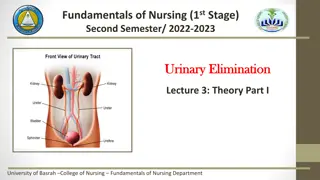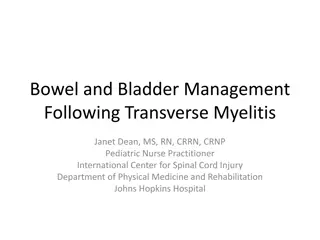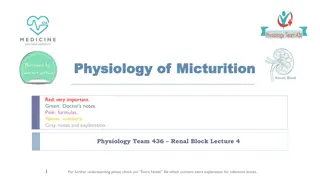Physiology of Micturition
The process of micturition (urination), the functional anatomy of the urinary bladder, neural control, the mechanism of filling and emptying of the bladder, and the neurogenic control of the micturition reflex and its disorders.
16 views • 23 slides
Urinary Elimination: Anatomy, Physiology, and Function of the Kidneys
The lecture covers the fundamentals of urinary elimination focusing on the kidneys' location, structure, function, and the role of nephrons. It discusses the transport of urine through the ureters to the bladder, highlighting the bladder's muscle layers and the urethra's role in expelling urine. Stu
6 views • 37 slides
Comprehensive Guide to Continuous Bladder Irrigation (CBI)
Explore the essential information about Continuous Bladder Irrigation (CBI), including its procedure, indications, supplies and equipment needed, documentation guidelines, and monitoring protocols. Learn about the importance of CBI in post-prostate surgery, urinary tract obstruction prevention, clot
5 views • 14 slides
Quick MD Care_ Your Trusted Partner in Primary Care Medicine
Quick MD Care: Your Trusted Partner in Primary Care Medicine\n\nWelcome to Quick MD Care, where compassionate primary care meets convenience. We understand the importance of having a trusted partner in managing your health. Our team of dedicated primary care doctors is committed to providing persona
5 views • 2 slides
Primary Care Services: Comprehensive Health Management for Everyone
Primary Care Services: Comprehensive Health Management for Everyone\n\nPrimary care services are the foundation of a robust healthcare system, ensuring that individuals have access to comprehensive, continuous, and coordinated care. These services are typically provided by primary care medical cente
3 views • 2 slides
Urinary Incontinence in the Elderly
The urinary system plays a vital role in regulating blood volume, pressure, and waste excretion. Urinary incontinence in the elderly can be caused by weak bladder muscles or neurological issues. The bladder consists of 4 layers, each serving a specific function. Normal voiding frequency and bladder
1 views • 50 slides
Palliative Care: Enhancing Quality of Life in Serious Illness
Palliative care is a holistic approach focused on improving the quality of life for patients and their families dealing with life-threatening illnesses. It involves early identification, assessment, and treatment of pain and other physical, emotional, and spiritual issues. This comprehensive trainin
1 views • 60 slides
Veterinary Anatomy of Urinary System in Different Animals
The urinary system in animals includes kidneys, ureters, and the bladder, all crucial for filtration and urine excretion. The ureters are excretory ducts from the kidneys, while the bladder stores urine before expulsion. Various diagrammatic structures illustrate the urogenital system of animals, pa
0 views • 20 slides
Understanding the Symptoms of UTI Bladder Infection
This comprehensive guide will explore the symptoms of UTI bladder infections, risk factors, prevention strategies, and treatment options.
0 views • 5 slides
Child Care and Youth Programs at Minot AFB
Offering a range of child care services including Child Development Center for ages 6 weeks to 5 years, School Age Care for Kindergarten to 12 years, Family Child Care Program, and Youth Programs for ages 9-18. Services include full-time care, before/after school care, extended duty care, emergency
2 views • 6 slides
Enhancing Palliative Care in Australian Residential Aged Care
PACOP, funded by the Australian Government Department of Health and Aged Care, is a program focused on improving palliative care in residential aged care facilities. It involves standardized assessment practices, early identification of care needs, and a collaborative model for sustainable support.
0 views • 10 slides
The Anatomy of Ureters, Urinary Bladder, and Urethra
Explore the detailed anatomy of ureters, urinary bladder, and urethra in this comprehensive guide. Learn about the course of ureters, important relations of the urinary bladder, and differences in male and female urethra. Discover the sites of ureteric constrictions, arterial blood supply, and more.
0 views • 22 slides
Overview of Bladder Tumours: Causes, Symptoms, and Diagnosis
Bladder tumours, particularly Transitional Cell Carcinoma (TCC), are the second most common cancer in the genitourinary system. Mainly caused by factors like cigarette smoking, industrial toxins, and genetic events, bladder cancer presents with symptoms such as hematuria and irritative voiding sympt
0 views • 26 slides
Priorities and Quality Measures for Type 2 Diabetes Care in NHS GGC
Dr. Kashif Ali leads primary care for Type 2 diabetes, while Dr. James Boyle oversees secondary care in NHS GGC. The data from December 2018 shows the number of Type 2 diabetes patients, their care processes, HbA1c levels, and BMI status. The Diabetes Quality Improvement and Outcome Measures aim to
0 views • 27 slides
Gall Bladder Cancers in India: A Report from Population Based Cancer Registries (1982-2010)
This report discusses the incidence rates of gall bladder cancers in various regions worldwide, focusing on India. It highlights the significant disparity in rates across different countries and regions. The data analysis includes age-adjusted incidence rates from specific districts in India, as wel
0 views • 34 slides
Management of Overactive Bladder (OAB) - Overview and Guidelines Update
Learn about the assessment, tests, conservative and surgical management options for Overactive Bladder (OAB) based on the new draft NICE guideline updates. Understand the categorization of urinary incontinence types, urine testing protocols, bladder diaries, quality of life assessments, and the role
1 views • 30 slides
Child Care Challenges in Kentucky: The Child Care Cliff
Explore the landscape of child care in Kentucky, revealing the challenges families face with the Child Care Cliff. Discover statistics on child care centers, family child care homes, and the average cost of child care in Kentucky. Understand the importance of the Child Care Assistance Program (CCAP)
0 views • 18 slides
Suprapubic Catheter Insertion Procedure Guidelines
Suprapubic catheter insertion is a procedure indicated for conditions such as urethral injury, obstruction, bladder neck masses, and benign prostatic hypertrophy. It involves proper patient positioning, analgesia, equipment preparation, and a step-by-step technique including bladder palpation, marki
1 views • 12 slides
Bowel and Bladder Management Post Transverse Myelitis
Following transverse myelitis, there can be significant changes in bowel and bladder function, impacting storage, release, and coordination. Neurogenic bowel and bladder issues, differentiated by injury level, can lead to challenges in controlling sphincters and bathroom habits. Understanding these
0 views • 23 slides
Case Study: Bladder Exstrophy in Infant - Presentation and History
Bladder exstrophy case study of a 12-day-old female infant with abnormal swelling and opening in the lower abdomen since birth. The patient's history includes antenatal, natal, and postnatal details without complications. Family-social background information is provided.
0 views • 35 slides
Development of the Urinary Bladder and Urethra in Embryology
Understanding the embryonic development of the urinary bladder and urethra involves studying the formation of the cloaca, division of the urogenital sinus, absorption of mesonephric ducts, position and fate of the urachus, and anomalies related to these structures. The cloaca, primitive urogenital s
0 views • 14 slides
Bowel and Bladder Issues Post Stroke
Bowel and bladder incontinence are common after a stroke, often due to brain damage affecting control functions. Factors like mobility can exacerbate these issues, leading to discomfort, infections, and other complications. Managing incontinence involves assessing individual needs, recognizing signs
0 views • 10 slides
Minot Air Force Base Family Child Care Programs
Offering a variety of child care services including Child Development Center (CDC) for infants to 5 years old, School Age Care (SAC) for Kindergarten to 12 years, Youth Programs for ages 9-18, and Family Child Care Program (FCC) for infants to 12 years. Additional programs include Extended Duty Care
0 views • 6 slides
Impacts of Marketisation on Home Care for Older People in Urban China
This study by Wenjing Zhang from the University of Bristol delves into the effects of the marketisation process on home care for the elderly in urban China. It explores the rationale behind the marketisation of care, the trends in home care marketisation, and the processes involved. The background s
0 views • 19 slides
Alterations in Genitourinary Function: An Overview
The genitourinary system comprises the urinary and reproductive organs, with the kidneys, ureters, bladder, and urethra playing crucial roles. Maintaining proper function involves factors like renal blood flow, glomerular filtration, tubular function, and urine flow. Nephrons are the functional unit
0 views • 58 slides
Cystitis: Causes, Symptoms, and Treatment Options
Cystitis is a common bladder infection that can affect both men and women. This lecture provides important information on the pathogenesis, causative organisms, diagnosis, and treatment of cystitis. Learn about the risk factors, types of cystitis, and how venereal diseases can present with symptoms
0 views • 16 slides
Updates on TNM-8 Staging for Urological Cancers: Insights by John Mitchard
An update by Consultant Histopathologist John Mitchard on TNM-8 staging for urological cancers, highlighting changes in RCC definitions and grading, along with minor adjustments in bladder staging. Details include revised pT3 criteria for kidney tumors, improvements in bladder M1 and T2 classificati
0 views • 14 slides
The Physiology of Micturition: Bladder Function and Control Mechanisms
Explore the intricacies of micturition physiology focusing on the functional anatomy of the urinary bladder, mechanism of filling and emptying, cystometrogram, and neurogenic control. Delve into the internal structure of the bladder, sphincters, and innervation in males for a comprehensive understan
0 views • 20 slides
Subacute Care: Types of Residents and Care Settings
Subacute care involves providing specialized care for individuals who require more attention than what typical long-term care facilities can offer. This level of care is provided in settings like hospitals or certain units within long-term care facilities. Residents in subacute care settings need a
0 views • 62 slides
Stroke Continence Protocols for Managing Bladder and Bowel Function After Stroke
This protocol outlines the management of urinary and bowel incontinence in stroke patients, emphasizing high nursing care levels and avoiding unnecessary catheterization. It discusses normal bladder functions, urinary dysfunction prevalence post-stroke, and interventions for promoting continence. Ur
0 views • 30 slides
The Human Urinary System
The human urinary system consists of the kidneys, ureters, bladder, and urethra. The kidneys filter blood to produce urine, which is carried to the bladder through the ureters for storage until excretion. Each kidney is structured with renal pyramids and nephrons for blood filtration and waste remov
0 views • 16 slides
Gall Bladder and Bile Duct
The gall bladder and bile ducts play crucial roles in the storage and transportation of bile in the body. They have specific anatomical divisions and functions, including bile secretion, concentration, and storage. Understanding their structure and function is essential for grasping their physiologi
0 views • 32 slides
Comprehensive Overview of Immunotherapy in Bladder and Renal Cancer Management
Explore the latest advancements in immunotherapy for managing bladder and renal cancer, including mechanisms of action, indications, adverse effects, and available treatment regimes. Learn about immune checkpoint inhibitors, differentiating immunotherapy from chemotherapy, indications for use across
0 views • 19 slides
Voiding Disorders in Children: An Overview by Dr. Manas Kr. Mahapatra
Voiding disorders in children, also known as bladder dysfunction, are a common issue affecting up to 40% of pediatric urology clinic visits. These disorders can indicate underlying pathophysiology requiring treatment to prevent renal or urologic damage. The development of urinary control by age 5 is
0 views • 53 slides
Urinary System: Bladder Anatomy and Function
Exploring the anatomy and physiology of the urinary system with a focus on the bladder, including details on muscle structure, capacity for urine collection, and the role of the detrusor muscle in micturition. Learn about key components such as the trigone and bladder neck, as well as innervation an
0 views • 19 slides
Continence Care in the Community
Continence care in the community focuses on maintaining normal bladder and bowel functions to support individuals in managing their toileting needs effectively. Continence involves being aware of bodily signals, knowing when and how to void or defecate, managing clothing, storing urine or bowel move
0 views • 38 slides
Overactive Bladder: Symptoms and Treatment Options
Overactive bladder (OAB) is a common condition characterized by urinary urgency, frequency, and sometimes incontinence. It significantly impacts quality of life and can affect individuals of all ages, with higher prevalence in older populations. Treatment options include drug therapy, bladder traini
0 views • 47 slides
Bladder Trauma: Etiology, Pathophysiology, and Management
Bladder trauma commonly occurs due to pelvic trauma or surgical interventions, leading to injuries like contusion, intraperitoneal rupture, and extraperitoneal rupture. Dr. Nagwa M. Ahmed presents key elements of bladder trauma, including its etiology, pathophysiology, clinical presentation, diagnos
1 views • 16 slides
Palliative Care Conversations
The critical aspects of palliative care, from diagnosis of life-limiting illnesses to end-of-life care options. Understand the importance of palliative approach and specialist care referrals. Discover how palliative care can alleviate uncertainties, emotional distress, and various symptoms, providin
0 views • 42 slides
MICTURATING CYSTOURETHROGRAM
Micturating cystourethrogram (MCU) is a diagnostic imaging test used to assess bladder and urethra function. It is indicated in adults for UTIs, voiding difficulties, and reflux, and in children for trauma and congenital anomalies. The procedure involves catheter insertion with contrast media to vis
0 views • 7 slides







































